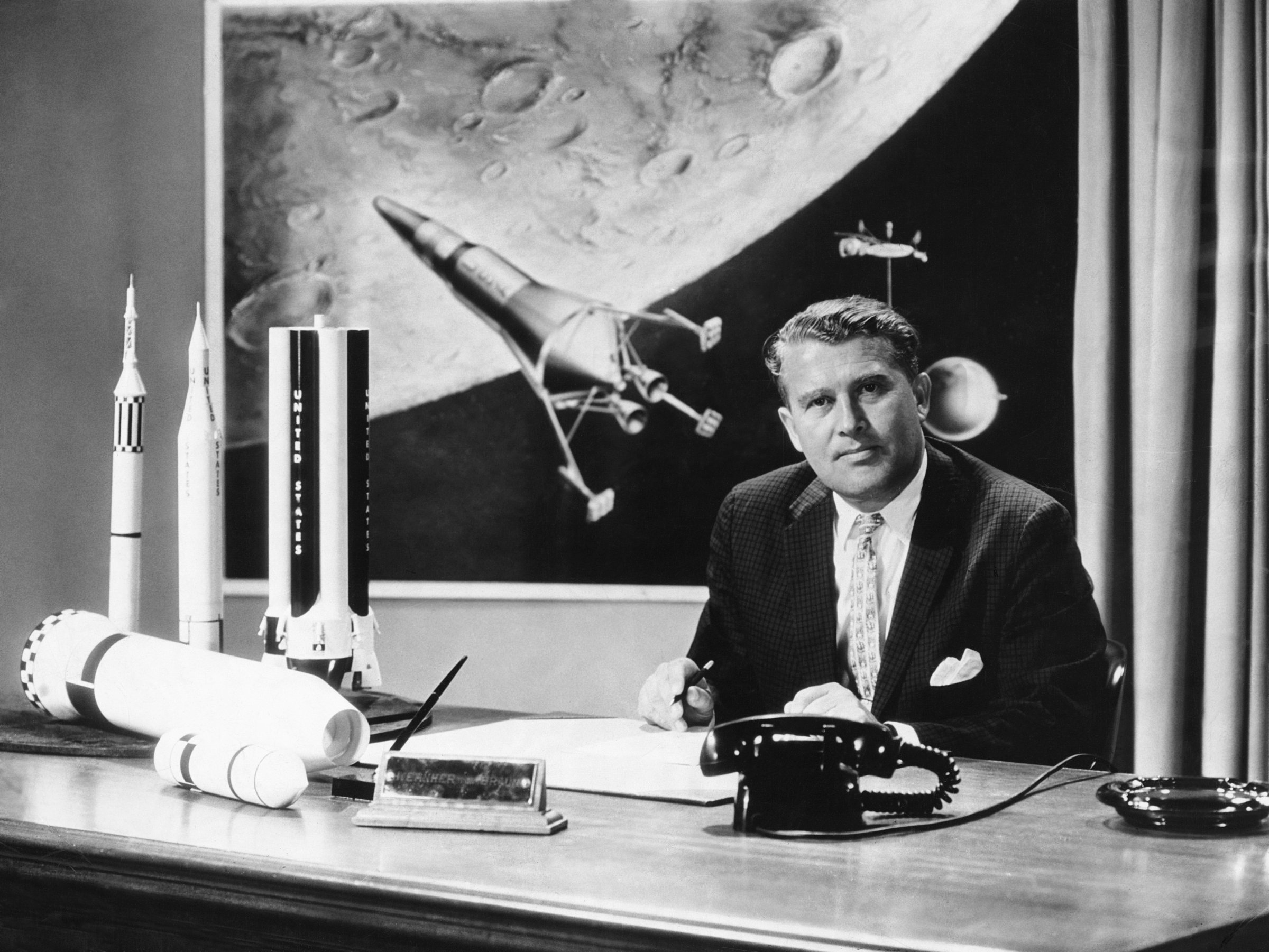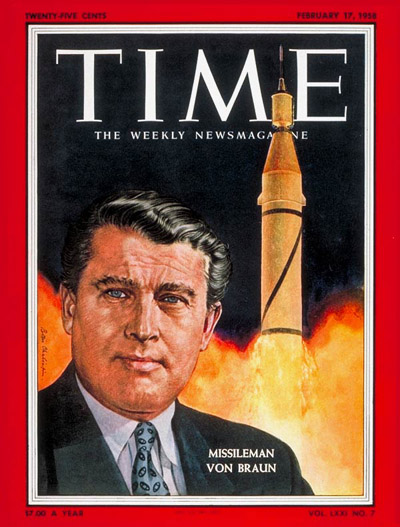
Sporting a gray double-breasted suit, slicked-back curls and a slide rule, rocket engineer Wernher von Braun cuts a suave, authoritative figure in Disney’s 1955 television special Man and the Moon. Speaking with a German accent, the then-director of development at the U.S. Army Ballistic Missile Agency in Huntsville, Ala., uses a series of models and illustrations to explain how America will reach the moon — with the aid of an enormous nuclear-powered space station, of course.
The United States eventually planted a flag on the lunar surface, though without the help of any orbital reactors. And all through the Space Race, von Braun, a German scientist scooped up by the U.S. in the waning days of World War II, was the public face of the American space program, as well as one of its chief architects. But much of the Cold War-era coverage of von Braun downplayed the darker details of his past: before he was building rockets for America, he was building them for Hitler. Germany launched more than 3,000 missiles of his design against Britain and other countries, indiscriminately killing approximately 5,000 people, while as many as 20,000 concentration camp prisoners died assembling the weapons.
In the years since the original Space Race has ended, historians have begun to reassess von Braun’s legacy. Some have portrayed his time working for the Nazis as a survival strategy, but others have gone so far as to frame him as a war criminal, or something close to it. Von Braun died in 1977, so there’s no possibility of hearing him out. But as the country and the world celebrates the 50th anniversary of the Apollo 11 moon landing — a feat that might not have been possible without von Braun’s contributions — his image, as Cold War hero, whitewashed Nazi villain or something in between, is being debated more fiercely than ever, as is the extent of America’s moral bargaining in using him to propel its otherworldly ambitions.
Looking back on the father of the American lunar program, there are few easy answers.
Born to an aristocratic Prussian family, Wernher von Braun became obsessed with space travel early in life, studying fields like physics and mathematics in order to grasp the fundamentals of rocketry. As a young man, he launched primitive rockets with other enthusiasts at an abandoned ammunition dump in suburban Berlin. The experiments, and von Braun’s leadership of the group, piqued the interest of the German army. In 1932, the 20-year-old wunderkind became the top civilian specialist at the German army’s Kummersdorf rocket station, south of Berlin. By 1935, von Braun’s group had successfully fired two rockets using liquid-fueled engines, a then-embryonic technology that became the basis for modern spaceflight. The facility was soon moved to a new location on the Baltic coast at Peenemünde.
With the start of World War II in 1939, von Braun came under increasing pressure to produce useful military weapons. He delivered. In 1942, his group successfully tested the A-4 missile, firing the weapon nearly 60 miles into the atmosphere. The trial caught Hitler’s attention, and the Reich began to mass produce the rockets at a feverish pace, often using slave labor. (The project also drew the interest of Heinrich Himmler’s Schutzstaffel (SS), which briefly imprisoned von Braun as part of an attempted takeover of the program.) By the later stages of the war, when von Braun’s missiles began to rain down on London, Nazi propaganda had given them a new name: the Vengeance Weapon Two, or V-2, so named because they were intended as retribution for Allied bombings of German cities.
The V-2 was a particularly terrifying weapon. The missiles traveled so fast that victims, most of whom were civilians, often heard nothing until after they struck. For his part, von Braun, who was apparently still interested in space travel, is said to have remarked that the rockets worked perfectly, except for landing on the wrong planet — a line that, at best, paints him as detached from the consequences of his work. But as fearsome as the V-2 was, it had little strategic impact and failed to turn the war in Germany’s direction. As the Allies advanced into the heart of Germany, von Braun and his engineering team headed south to surrender to the Americans, rather than await the Red Army.
Von Braun was one of about 120 German scientists who, in a then-secret U.S. project known as Operation Paperclip, were taken to the U.S. to develop military technology. Rather than be held accountable like other important figures in Nazi Germany, they were given new lives. The Soviet Union also took German scientists for similar reasons, foreshadowing the superpower showdown that was to come.
Once he was settled in the U.S., von Braun’s career took off, largely fueled by the U.S.-Soviet technological rivalry that would develop into the Space Race. By 1953, his team developed America’s first ballistic missile, the Redstone, which could hurl a nuclear warhead up to 250 miles downrange. The Jupiter-C, a modified version of the Redstone, launched the United States’ first satellite, Explorer 1, in 1958 — a full year after the Soviets launched their first satellite, Sputnik 1. A von Braun TIME cover arrived in 1958, with the engineer’s calm, coifed likeness superimposed over the flames of a missile launch. Von Braun later became director of NASA’s Marshall Space Flight Center, developing the behemoth Saturn V rocket, which 50 years ago this week carried Neil Armstrong and Buzz Aldrin to the moon’s surface, while Michael Collins waited in lunar orbit.
The cheerful, well-spoken von Braun became the center of America’s space obsession: an extraordinary engineer, communicator and manager who promised America the moon and delivered, beating the arch-rival Soviets in the process. But his past wasn’t completely hidden. TIME noted in 1958 that, to some, Von Braun’s “transfer of loyalty from Nazi Germany to the U.S. seemed to come too fast, too easy.” That sentiment was echoed in a 1967 song by satirist Tom Lehrer: “Once the rockets are up, who cares where they come down? / That’s not my department, says Wernher von Braun.”

More recent examinations of von Braun’s life have gained distance from the nationalistic fervor that prevailed at the height of the Space Race. In Von Braun: Dreamer of Space, Engineer of War, Michael Neufeld, former chair of the Smithsonian National Air and Space Museum’s space history department, sheds light on how knowledge of von Braun’s collaboration with the Nazi regime was purposefully suppressed. But Neufeld stops short of casting him as a complete villain. It would have been dangerous for von Braun to complain to Nazi leadership about his work or the conditions in which his missiles were made, Nuefeld says. He also argues that von Braun’s membership in the SS, which was classified information in the U.S., was at least somewhat coerced. But at the same time, the “missileman” seldom if ever seemed to consider anything beyond advancing his own career.
“He was not ideologically very interested in Nazi ideas,” says Nuefeld. “Although he was happy to profit from his status as an Aryan aristocrat.”
A more damning take comes from Wayne Biddle, a Pulitzer Prize-winning journalist and author of Dark Side of the Moon. Biddle frames von Braun as a war criminal with direct involvement in the V-2 slave labor project, and a man who only escaped justice thanks to the efforts of the American government, which was desperate for help in beating the Soviets.
“One always has a choice in life, and [von Braun] never made a choice that moved him away from the Nazi regime,” says Biddle. He also echoes Nuefeld’s characterization of von Braun as career-obsessed. “He always made choices that resulted in his rapid advancement at a very young age.”
But von Braun wasn’t the only one who prioritized success. Confronted with the growing power of Stalin’s U.S.S.R., the U.S. Government sanitized von Braun and other German scientists’ images in order to use their skills; to a large extent, the American public went along with it. “There was public protest in early 1947 over the importation of the Germans,” explains Nuefeld. “And then Cold War heat got worse, and it pretty much went away.”
That moral calculation enabled von Braun to become an iconic leader in the American space program, admired by many and untouchable out of sheer national necessity. Decades later, Biddle argues, the reassessment of his legacy may have had less to do with a growing understanding of his crimes than the fact that the engineer was simply no longer needed. “[Von Braun] was brought over originally to milk his knowledge,” says Biddle. “Once that was used up, he became expendable.”
That we’re still debating Wernher von Braun’s legacy 50 years after his rockets put men on the moon speaks to the profound effect he had on America’s image. And while he was undeniably an engineering genius, that this onetime cog in the Wehrmacht died a largely unquestioned American hero speaks to what was perhaps his greatest skill: salesmanship. To survive in Nazi Germany, he sold Hitler a dream of victory through superior technology. Later, he sold the U.S. Army a vision of intercontinental nuclear dominance. But von Braun’s biggest sale of all is apparent in that Disney footage. To Americans, he sold the dream of men in space and flags on the moon. And by and large, the nation bought it, no questions asked.
More Must-Reads from TIME
- Cybersecurity Experts Are Sounding the Alarm on DOGE
- Meet the 2025 Women of the Year
- The Harsh Truth About Disability Inclusion
- Why Do More Young Adults Have Cancer?
- Colman Domingo Leads With Radical Love
- How to Get Better at Doing Things Alone
- Michelle Zauner Stares Down the Darkness
Write to Alejandro de la Garza at alejandro.delagarza@time.com